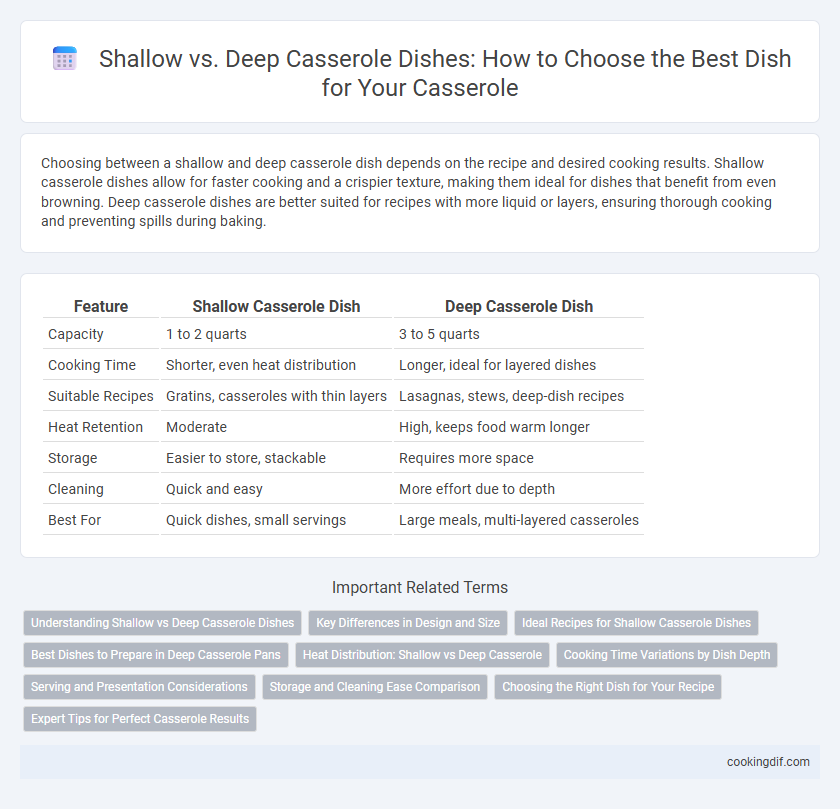Choosing between a shallow and deep casserole dish depends on the recipe and desired cooking results. Shallow casserole dishes allow for faster cooking and a crispier texture, making them ideal for dishes that benefit from even browning. Deep casserole dishes are better suited for recipes with more liquid or layers, ensuring thorough cooking and preventing spills during baking.
Table of Comparison
| Feature | Shallow Casserole Dish | Deep Casserole Dish |
|---|---|---|
| Capacity | 1 to 2 quarts | 3 to 5 quarts |
| Cooking Time | Shorter, even heat distribution | Longer, ideal for layered dishes |
| Suitable Recipes | Gratins, casseroles with thin layers | Lasagnas, stews, deep-dish recipes |
| Heat Retention | Moderate | High, keeps food warm longer |
| Storage | Easier to store, stackable | Requires more space |
| Cleaning | Quick and easy | More effort due to depth |
| Best For | Quick dishes, small servings | Large meals, multi-layered casseroles |
Understanding Shallow vs Deep Casserole Dishes
Shallow casserole dishes typically hold 1.5 to 2 quarts, allowing for quicker cooking and crispier edges, making them ideal for dishes like lasagna or gratins. Deep casserole dishes, often 3 to 4 quarts or more, provide space for layered recipes and larger portions, preventing overflow during baking. Choosing between shallow and deep depends on recipe requirements, portion size, and desired texture outcomes.
Key Differences in Design and Size
Shallow casserole dishes typically measure 1 to 2 inches in depth, providing a larger surface area that promotes faster, even cooking and ideal browning for dishes like gratins or casseroles with crunchy toppings. Deep casserole dishes range from 2.5 to 4 inches deep, allowing for more volume and layering of ingredients, perfect for recipes requiring longer cooking times and moisture retention, such as lasagnas or baked stews. The choice between shallow and deep designs depends on recipe requirements; shallow dishes deliver quicker cooking and crisp textures, while deep dishes accommodate larger portions and retain flavors through extended baking.
Ideal Recipes for Shallow Casserole Dishes
Shallow casserole dishes excel in recipes requiring even, quick baking such as gratins, scalloped potatoes, and baked pasta. Their wide surface area promotes crisp, golden tops and faster moisture evaporation, ideal for layered casseroles or dishes with cheese toppings. These dishes are best suited for recipes where browning and texture are essential to the final presentation.
Best Dishes to Prepare in Deep Casserole Pans
Deep casserole pans are ideal for layered dishes like lasagna, shepherd's pie, and baked ziti, where ample capacity ensures even cooking and moisture retention. Their depth accommodates larger portions and ingredients that expand during baking, such as rice casseroles and pot pies. Choosing a deep casserole dish enhances the texture and flavor development in recipes requiring extended cooking times.
Heat Distribution: Shallow vs Deep Casserole
Shallow casserole dishes provide quicker and more even heat distribution, promoting faster cooking and browning, ideal for dishes requiring a crisp top. Deep casserole dishes retain heat longer but may heat less uniformly, which benefits slow-cooked, layered meals that need gradual, sustained heat. Selecting between shallow and deep depends on cooking style and heat transfer efficiency desired for the recipe.
Cooking Time Variations by Dish Depth
Shallow casserole dishes promote faster cooking times due to increased surface area and more even heat distribution, which allows ingredients to cook quickly and develop a crispier texture. Deep casserole dishes retain heat longer and accommodate larger volumes, resulting in slower cooking times but enhanced moisture retention and tenderness. Choosing the appropriate dish depth directly impacts overall cooking efficiency and final dish consistency.
Serving and Presentation Considerations
Shallow casserole dishes are ideal for even cooking and attractive, layered presentations, making them perfect for dishes that require a visually appealing top crust or toppings. Deep casserole dishes accommodate larger portions and are suitable for heartier meals, ensuring ample servings for family-style dining. Selecting between shallow and deep depends on whether the emphasis is on elegant presentation or generous serving sizes.
Storage and Cleaning Ease Comparison
Shallow casserole dishes offer easier storage due to their compact height, fitting more efficiently in cabinets and refrigerators compared to deep dishes. Their reduced depth also simplifies cleaning, as food residue is less likely to settle in hard-to-reach corners, minimizing scrubbing time. In contrast, deep casserole dishes require more space and thorough cleaning efforts, especially for baked-on ingredients.
Choosing the Right Dish for Your Recipe
Selecting the right casserole dish depth is critical for even cooking and optimal texture; shallow dishes (1.5 to 2 inches deep) work best for recipes that require a crispy top and quick baking, such as gratins or casseroles with thin layers. Deep casserole dishes (3 inches or more) accommodate larger portions and thicker layers, ideal for recipes with multiple ingredients that need slower, thorough cooking to blend flavors fully. Ensure the dish size matches your recipe's volume to prevent overflows or inadequate cooking.
Expert Tips for Perfect Casserole Results
Choosing the right casserole dish depth significantly impacts cooking times and texture; shallow dishes promote even browning and quicker cooking, ideal for crispy toppings. Deep casserole dishes excel in retaining moisture and accommodating layered recipes, preventing overflow during baking. Experts recommend matching dish depth to recipe structure--shallow for thin, evenly cooked casseroles, and deep for hearty, multi-layered meals to achieve perfect results.
Shallow vs Deep for casserole dish selection Infographic

 cookingdif.com
cookingdif.com